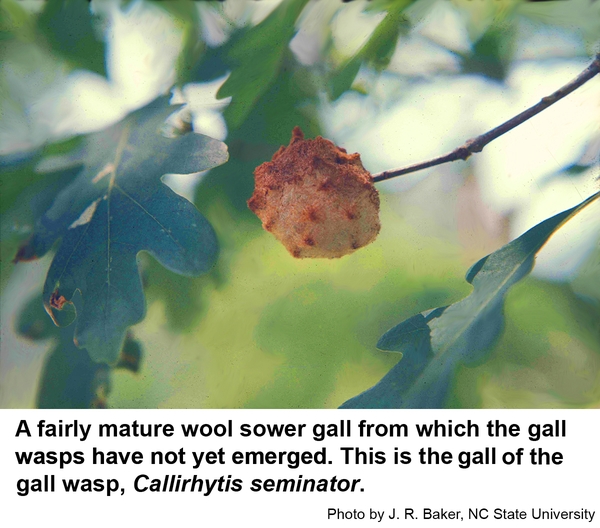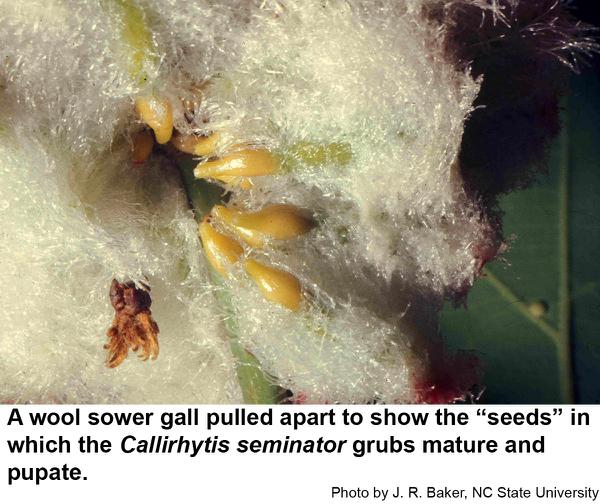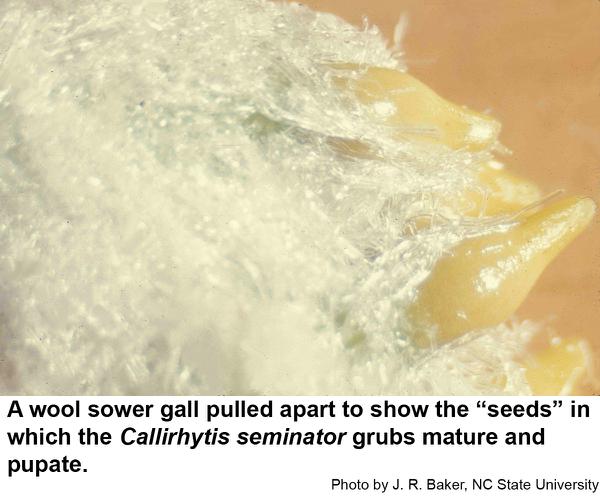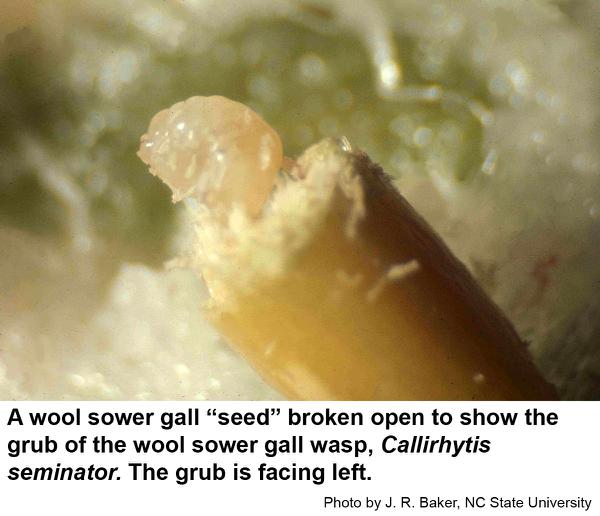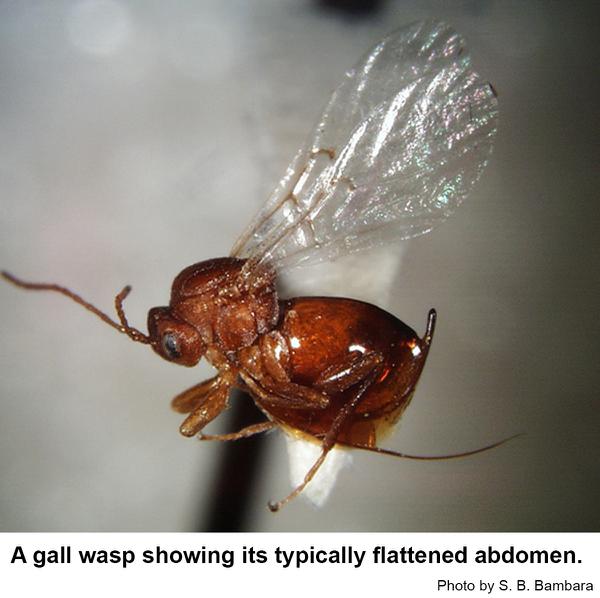Description and Biology
The wool sower gall is a distinct and unusual plant growth induced by the secretions of the grubs of a tiny gall wasp, Callirhytis seminator. These wasps are about 1/8 inch long, dark brown, and their abdomens are noticeably flattened from side to side. The grubs are translucent to white, plump, and legless. Their heads are more or less shapeless blobs. The wool sower gall is specific to white oaks and only occurs in the spring. When the gall is pulled apart, inside are small seed-like structures inside of which the gall wasp grubs develop (the wool sower gall is also called the oak seed gall). Gall wasps have alternation of generations in which one generation develops in one type of gall (leaf gall) and their offspring develop into another type of gall (stem gall). Wasps of each alternate generation are slightly different in size and the galls of each generation are enormously different from the parent's. We don't know what the alternate generation galls of the wool sower gall wasp look like. If a fresh wool sower gall is held in a plastic bag out of the sun (so it won't get too hot) within a week or three, tiny gall wasps will emerge usually from mid June to early July. These wasps are harmless to people. Fortunately, wool sower galls are hardly ever abundant enough to cause real harm to white oaks.
Host Plant
White oak seems to be the primary host for the wool sower gall wasp in North Carolina. Chestnut oak (also called rock chestnut oak, rock oak, or tanbark oak) and Swamp white oak have also been listed as hosts.
Residential Recommendations
By the time the galls are noticed, it is way too late to control the gall wasps. The grubs are well protected by the amazing gall tissues. If a tree has so many wool sower galls that it's overall health seems to be threatened, spraying the tree with a pyrethroid in mid June might help lower the number of galls for the next year. Pyrethroids are very toxic to insects but are not particularly hazardous to humans and pets (other than fish⸺avoid using pyrethroids around pools, ponds, and streams). Pyrethroids labeled for residential landscape use are readily available in most big box stores, plant centers, and nurseries. The active ingredient of all pesticides are listed on the front label usually in very small font near the bottom. The active ingredient of pyrethroids ends with "-thrin." Pyrethroids other than resmethrin and pyrethrum have a long residual life in the environment so one treatment should protect the tree for several weeks. When used as directed, pyrethroids are very toxic to insects but are not particularly hazardous to humans and pets (other than fish-avoid using pyrethroids around pools, ponds, and streams).
References
- Fragments on North American insects IX. Girault, A. A. 1915. Ent. News 26: 219-227.
- Gall Identification Guide. Kranz, A. and J. Clark. 2021. GallForners.Org
- Galls on Oaks. Frank, S. et al. 2002. Entomology Insect Notes, NC State Extension Publications.
- On the cynipidous galls of Florida, with descriptions of new species and synopses of the described species of North America. Ashmead. W. H. 1887. Trans. Amer. Entomol. Soc. 14: 125-158.
- Species Callirhytis seminator - Wool Sower. Anonymous. 2003 or afterward. Bug Guide. Iowa State University Department of Entomology.
- Wool-sower gall. Robert, B. 2017. The Scott Arboretum of Swarthmore College. https://www.scottarboretum.org/wool-sower-gall/
- NC State Extension Plant Pathology Publications
- NC State Horticultural Science Publications
- North Carolina Agricultural Chemicals Manual
For assistance with a specific problem, contact your local N.C. Cooperative Extension center.
This factsheet has not been peer reviewed.
Publication date: May 10, 2017
Reviewed/Revised: March 1, 2022
Recommendations for the use of agricultural chemicals are included in this publication as a convenience to the reader. The use of brand names and any mention or listing of commercial products or services in this publication does not imply endorsement by NC State University or N.C. A&T State University nor discrimination against similar products or services not mentioned. Individuals who use agricultural chemicals are responsible for ensuring that the intended use complies with current regulations and conforms to the product label. Be sure to obtain current information about usage regulations and examine a current product label before applying any chemical. For assistance, contact your local N.C. Cooperative Extension county center.
N.C. Cooperative Extension prohibits discrimination and harassment regardless of age, color, disability, family and marital status, gender identity, national origin, political beliefs, race, religion, sex (including pregnancy), sexual orientation and veteran status.

